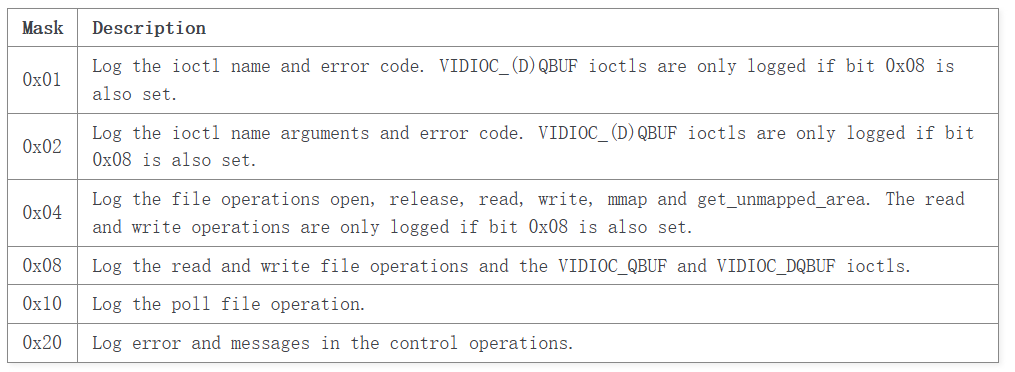Introduction
linux/samples/v4l/v4l2-pci-skeleton.c 有一个 driver 模板。
2.2 Structure of a V4L driver
device instances
|
+-sub-device instances
|
\-V4L2 device nodes
|
\-filehandle instances
2.3 Structure of the V4L2 framework
v4l2 framework 中分别使用以下几个结构体来依次代表上面的结构:
struct v4l2_devicestruct v4l2_subdevstruct video_devicestruct v4l2_fh
2.4 Video device
video device 用于抽象系统注册的 v4l2 /dev 设备节点,以便用户空间可以进行交互。
可以通过 video_device_alloc() 分配,也可以嵌入在更大的结构体中,这样则需要自定义 release 函数。
如果是嵌入在更大的结构体中,并且没有要释放的资源,可以使用 video_device_release_empty()。
最后通过 video_register_device() 注册。
struct video_device 其中一些 fields 需要我们手动去初始化,包括:
fops, device_caps, queue, ioctl_ops, lock, prio.
- video_device->v4l2_dev: 指向 v4l2_device。
- video_device->name: 名称。
- video_device->vfl_dir: VFL_DIR_RX/VFL_DIR_TX/VFL_DIR_M2M 表示 capture device/output device/m2m device.
- video_device->fops: v4l2_file_operations, 文件操作函数。
- video_device->ioctl_ops: ioctl 函数。
- video_device->lock: 初始化为一个 mutex。如果设置了,那么所有的 ioctls 都会串行化。
- video_device->queue: 指向 vb2_queue, 注意这边 m2m device 不用初始化该 field,因为 m2m device 每个打开 device node 的 app 都要维护一个 vb2_queue,而不是一个全局的 vb2_queue.
- video_device->prio: 用来实现 VIDIOC_G/S_PRIORITY, 如果为 NULL, 则会使用 v4l2_device->prio
如果需要和 media framework 联合使用,需要初始化嵌入在 video_device 中的 media_entity 成员,通过调用 media_entity_pads_init().
如果 v4l2 driver 使用 v4l2_ioctl_ops, 则 v4l2_file_operations 中的.unlock_ioctl 回调需要使用 video_ioctl2.
2.4.1 ioctls and locking
设置 video_device->lock 和 video_device->queue->lock 两个 mutex.
这样 v4l2 core 会自动调用 video_device->lock 和 video_device->queue->lock 来串行化 v4l2 ioctls 的执行。
video_device->queue->lock 用来单独串行化 v4l2 buffer 相关的 ioctls,这样和其他 ioctls 可以并行运行。
如果使用的是 queue->lock,那么 vb2_ops 中的 wait_prepare/finish 回调可以使用 vb2_ops_wait_prepare/finish() helper function.
2.4.2 Video device registration
err = video_register_device(vdev, VFL_TYPE_VIDEO, -1);
video_register_device() 最后一个参数是生成设备节点的编号,如果为 -1 则由内核自动分配,也可以自行指定一个编号。
不同的设备类型会生成不同的设备节点:

2.4.3 Video device debugging
每个 video device 都会创建一个 dev_debug, 往/sys/class/video4linux/<devX>/dev_debug写入数值可以调整 debug 等级:

2.4.4 Video device cleanup
video_unregister_device(), 或者使用 vb2_video_unregister_device()。
在这之前别忘记 clean up media_entity:
media_entity_cleanup (&vdev->entity)
2.4.5 helper functions
static inline void *video_get_drvdata(struct video_device *vdev)
static inline void video_set_drvdata(struct video_device *vdev, void *data)
struct video_device *video_devdata(struct file *file)
2.4.6 functions and data structures
struct video_device {
#if defined(CONFIG_MEDIA_CONTROLLER)
struct media_entity entity;
struct media_intf_devnode *intf_devnode;
struct media_pipeline pipe;
#endif
const struct v4l2_file_operations *fops;
u32 device_caps;
/* sysfs */
struct device dev;
struct cdev *cdev;
struct v4l2_device *v4l2_dev;
struct device *dev_parent;
struct v4l2_ctrl_handler *ctrl_handler;
struct vb2_queue *queue;
struct v4l2_prio_state *prio;
/* device info */
char name[64];
enum vfl_devnode_type vfl_type;
enum vfl_devnode_direction vfl_dir;
int minor;
u16 num;
unsigned long flags;
int index;
/* V4L2 file handles */
spinlock_t fh_lock;
struct list_head fh_list;
int dev_debug;
v4l2_std_id tvnorms;
/* callbacks */
void (*release)(struct video_device *vdev);
const struct v4l2_ioctl_ops *ioctl_ops;
DECLARE_BITMAP(valid_ioctls, BASE_VIDIOC_PRIVATE);
struct mutex *lock;
};
entity:
fops: v4l2 file operations.device_caps: 设备支持的能力,在 videodev2.h 中定义。v4l2_dev: 上层的 v4l2_device 设备。dev_parent: 上层的 device 设备,如果为 NULL 在 video_register_device 中会指向 v4l2_dev->devctrl_handler: 如果为 NULL, 在 video_register_device 中会指向 v4l2_dev->ctrl_handler.queue: 和该 device node 相关的 vb2_queue 结构体。prio: 如果为 NULL, 在 video_register_device 中会指向 v4l2_dev->prio .name: video device name.vfl_type: enum vfl_devnode_type, v4l2 设备的类型,在 video_register_device 中传入。vfl_dir: enum vfl_devnode_direction, 表示 v4l2 设备的方向,RX(capture device)/TX(output device)/M2M(mem2mem, codec).minor: device node 次设备号。num: video device node 的编号,/dev/videoX 的 X, 在 video_register_device 最后一个参数传入。flags: enum v4l2_video_device_flags, 一些辅助 flags.index: 一个物理设备对应多个 v4l2 设备节点,分别的 index. 每次调用 video_register_device() 都会增加 1.fh_lock: 用来 lock v4l2_fhs.fh_list: v4l2_fh 链表。dev_debug: userspace 通过 sysfs 设置的 debug level. /sys/class/video4linux/video0/dev_debugtvnorms: 支持的电视标准 PAL/NTSC/SECAM.release: 释放函数。在 video_device 没有 subclass 的情况下可以使用 video_device_release().
如果 video_device subclass 或者是 static 分配的,不需要释放内存使用 video_device_release_empty().ioctl_ops: v4l2 file ioctl operations.valid_ioctls: 支持的 ioctrl bitmap.lock: 用来串行化 v4l2 device 的 unlock_ioctl.
struct v4l2_ioctl_ops {
/* VIDIOC_QUERYCAP handler */
int (*vidioc_querycap)(struct file *file, void *fh,
struct v4l2_capability *cap)
/* VIDIOC_ENUM_FMT handlers */
int (*vidioc_enum_fmt_vid_cap)(struct file *file, void *fh,
struct v4l2_fmtdesc *f);
int (*vidioc_enum_fmt_vid_out)(struct file *file, void *fh,
struct v4l2_fmtdesc *f);
int (*vidioc_enum_fmt_vid_cap_mplane)(struct file *file, void *fh,
struct v4l2_fmtdesc *f);
int (*vidioc_reqbufs)(struct file *file, void *fh,
struct v4l2_requestbuffers *b);
int (*vidioc_querybuf)(struct file *file, void *fh,
struct v4l2_buffer *b);
int (*vidioc_qbuf)(struct file *file, void *fh,
struct v4l2_buffer *b);
int (*vidioc_expbuf)(struct file *file, void *fh,
struct v4l2_exportbuffer *e);
int (*vidioc_dqbuf)(struct file *file, void *fh,
struct v4l2_buffer *b)
int (*vidioc_create_bufs)(struct file *file, void *fh,
struct v4l2_create_buffers *b);
int (*vidioc_prepare_buf)(struct file *file, void *fh,
struct v4l2_buffer *b)
int (*vidioc_streamon)(struct file *file, void *fh,
enum v4l2_buf_type i);
int (*vidioc_streamoff)(struct file *file, void *fh,
enum v4l2_buf_type i);
int (*vidioc_try_fmt_vid_cap_mplane)(struct file *file, void *fh,
struct v4l2_format *f);
int (*vidioc_s_fmt_meta_cap)(struct file *file, void *fh,
struct v4l2_format *f);
long (*vidioc_default)(struct file *file, void *fh,
bool valid_prio, unsigned int cmd, void *arg);
}
vidioc_default: private ioctls 在这里实现。